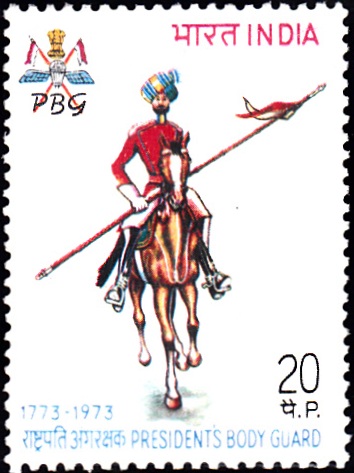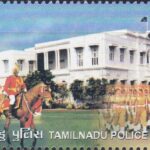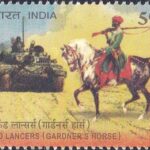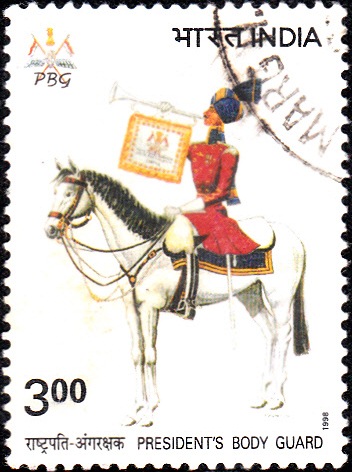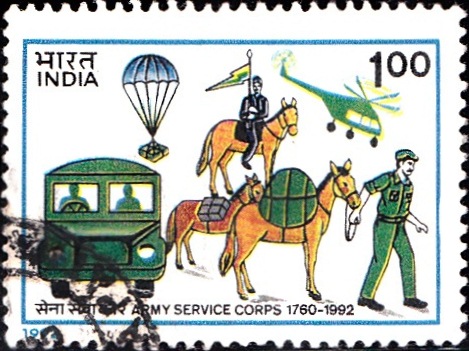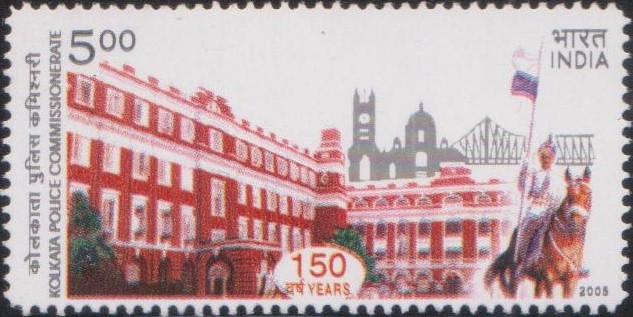
Deccan Horse
A commemorative postage stamp on the Presentation of Regimental Guidon to the 9th Deccan Horse (9 Horse), one of the oldest and most decorated armored regiments of Indian Army :
 Issued by India
Issued by India
Issued on Jan 9, 1984
Type : Stamp, Postal Used
Colour : Multi colour
Denomination : 100 Paise
Printed at : India Security Press
About :
- The Deccan Horse came into being as “Asif Jah’s Irregular Cavalry” in 1790. It was raised under the Colours of the Nizam of Hyderabad in Berar under terms of the subsidiary alliance with the East India Company.
- In 1816, the ‘Irregular Cavalry‘ was re-organised into four regiments of the ‘Reformed Horse‘. The change in names and titles continued throughout the 19th Century and The Deccan Horse was variously called 1st and 2nd Regiment Nizam’s Cavalry, 1st and 2nd Cavalry, Hyderabad Contingent, and, 1st and 2nd Lancers, Hyderabad Contingent. At the turn of the Century, in 1903, with the incorporation of the Hyderabad Contingent into the regular Indian Cavalry, the two regiments were styled XXth Deccan Horse and 29th Lancers (Deccan Horse). XXth Deccan Horse was titled ‘Royal’ for distinguished service during World War I, and in 1922 following amalgamation of the two regiments, the Royal Deccan Horse (9th Horse) came into being. On India becoming a Republic, the regiment’s name was finally changed to The Deccan Horse (9 Horse) in 1950.
- During the 18th and 19th Centuries, The Deccan Horse remained as a local crops in the Deccan being called out frequently on active service. The regiment won its first Victoria Cross in 1859 and was also awarded the battle honour, ‘Central India‘. Thereafter, the regiment saw action during the Second Afghan War (1879-1880), the Burma War (1886-1888) and in China (1900).
- The regiment fought in the First World War from the mud of Flanders to the sands of Palestine. It won over 230 decorations for gallantry including a Victoria Cross, and 11 battle honours “Givenchy, 1914“, “Somme, 1916“, “Bazentin“, “Delville Wood“, “Flers Courcellete“, “Cambrai, 1917“, “France & Flanders, 1914-18“, “Megiddo“, “Sharon“, “Damascus“, and “Palestine, 1918“.
- During the Second World War, having converted to tanks, the regiment took part in the re-conquest of Burma. It won 36 gallantry awards and five battle honours which included “Meiktilla and Rengoon Road”, “Capture of Meiktilla“, “Defence of Meiktilla“, “Pyabwe” and “Burma 1942-45“.
- Immediately after Independence, one squadron of the regiment fought in the Jammu and Kashmir Operations (1948-49) and was largely instrumental in the recapture of Chhamb.
- During the 1965 Indo-Pak conflict, the regiment saw fierce action in the Khem Karan Sector. It was responsible for creating the ‘Patton Graveyard’. The regiment won 24 decorations and battle honours “Asal Uttar” and “Punjab 1965″. The battle fought by the regiment broke the back of an enemy armoured and infantry division. The then Commandant of the Regiment, Lt. Col. (Now Gen.) A. S. Vaidya, was awarded the “Maha Vir Chakra” for leading the regiment gallantry.
- In the Indo-Pak conflict of 1971, The Deccan Horse was once again at the forefront of the hottest fight in Chhamb. Six Gallantry awards were won. The gallant battle by the Regiment blunted and stalled the largest offensive ever mounted by Pakistan since Independence. In recognition of its distinguished service, The Deccan Horse has now been selected for presentation of a “Guidon” by the President of India.
Subscribe
Login
0 Comments


